What Time Is Sunset Where I Am Now
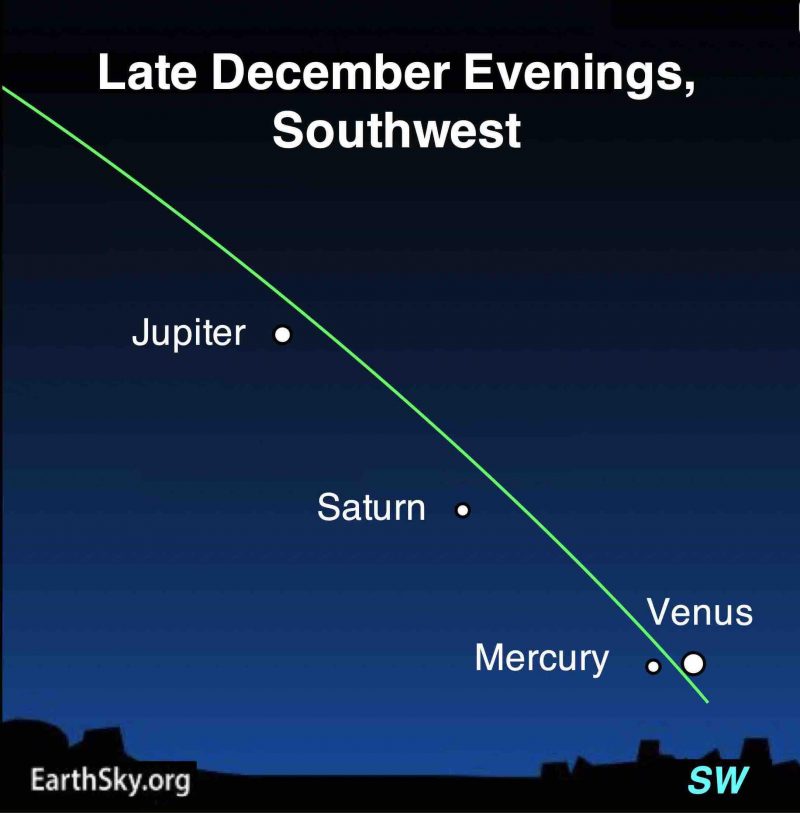
Find these available planets as the yr turns (late December 2021 and January 2022):
Venus
Jupiter
Saturn
Mercury
Mars
Plus:
Visible planets, stars, the moon and more
Solstice on December 21
Ursid meteor shower
Current sunrises follow the winter solstice
Earth closest to sun in too soon January
Dec 2021 and January 2022 heliocentric star system
December 2021 and January 2022 planets deep
EarthSky's 2022 lunar calendars are available now! We'rhenium guaranteed to sell out, so get one while you can. Makes a great present!
Visible planets, stars, the moon and more
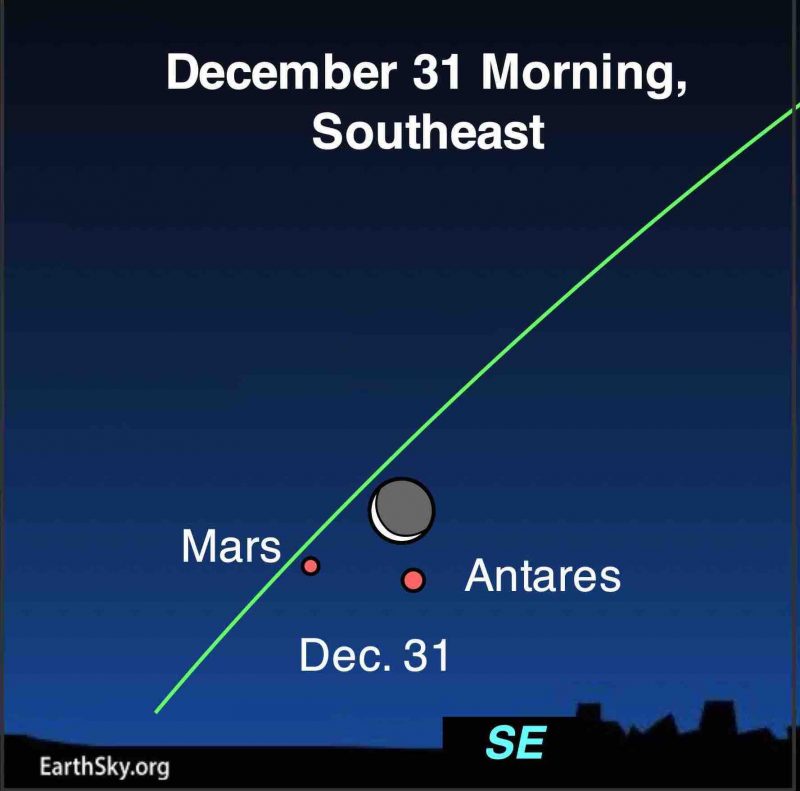
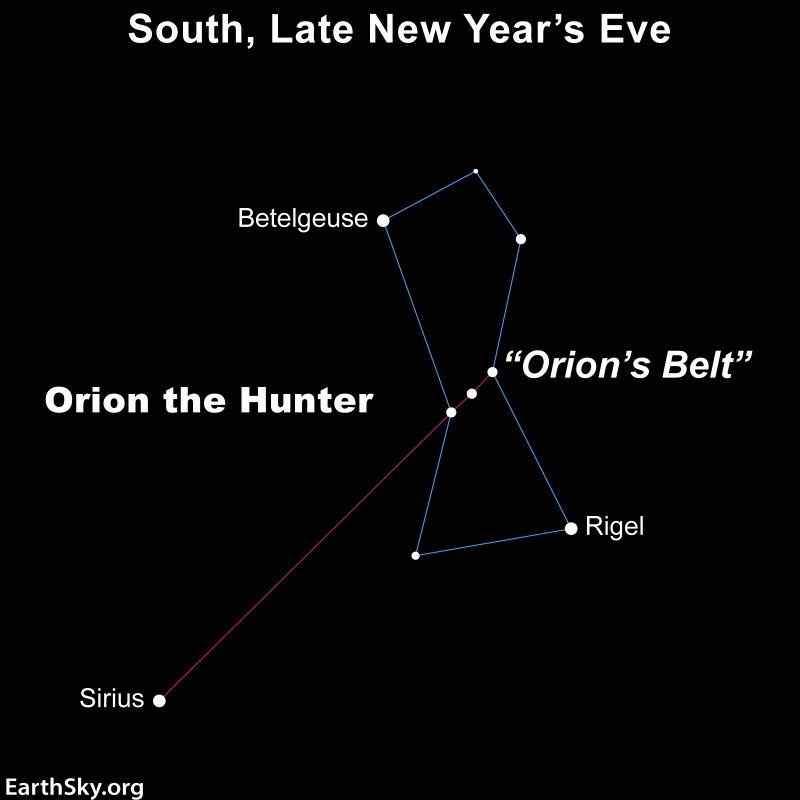
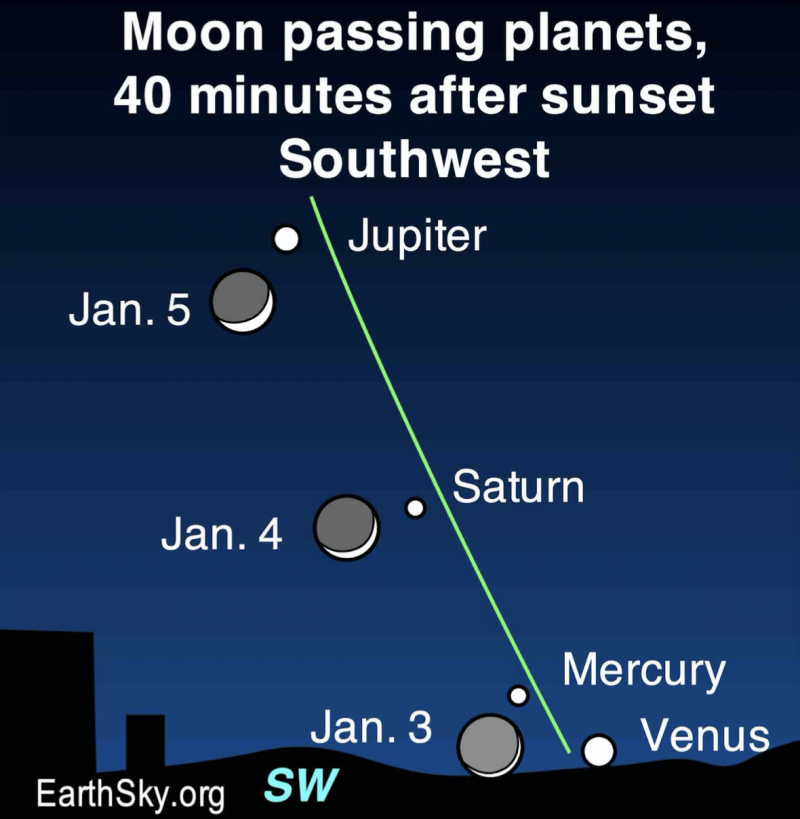
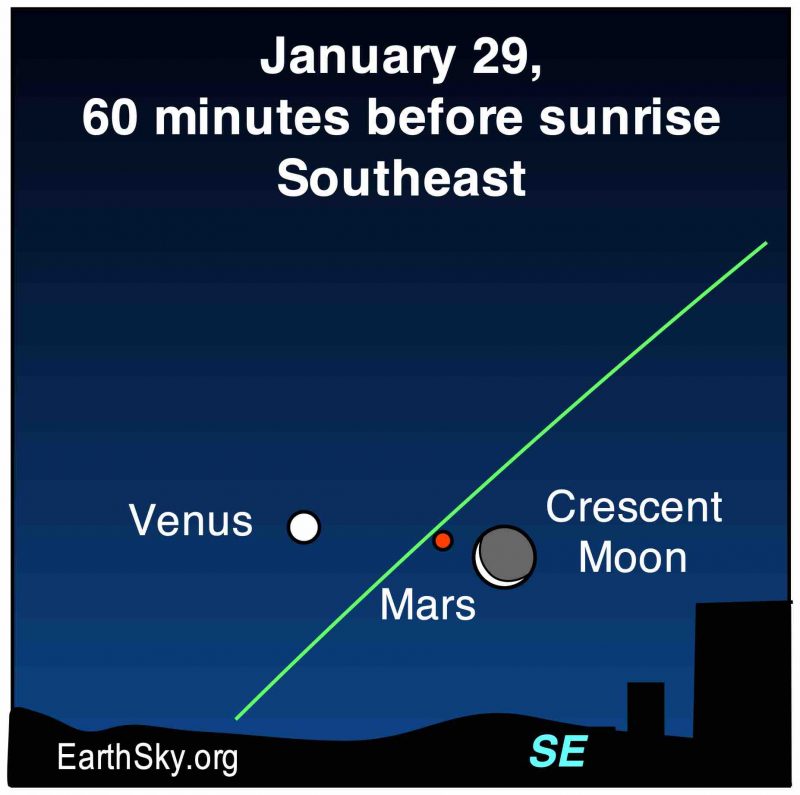
Solstice on Dec 21
The 2021 December solstice here and now – when the sun reaches its south point in the sky – happens connected December 21 at 15:59 UTC (9:59 a.m. CST; translate UTC to your time).
At this solstice, the sun reaches its most southerly point on the sky's dome for the year. And so, at this solstice, the Northern Cerebral hemisphere has its shortest day and longest Nox of the year. The Southern Hemisphere has its longest day and shortest night.
No matter where you live on Earth's globe – atomic number 102 matter what meter the solstice happens for you – information technology's a day to celebrate! It's a milestone in Earth's orbit and a marker of seasonal interchange. Read Thomas More about the December solstice.

Ursid shooting star shower around the solstice
The annual Ursid meteor shower runs from close to December 17 to 26 all class. It ever peaks around the December solstice, which, in 2021, comes on December 21. The Ursids' peak is probably the morning time of December 22, simply any of the next hardly a mornings should yield some Ursid meteors as well. Plus the Geminids are still exit on, and should likewise run until roughly Dec 22. Read more about the Ursid meteor shower.
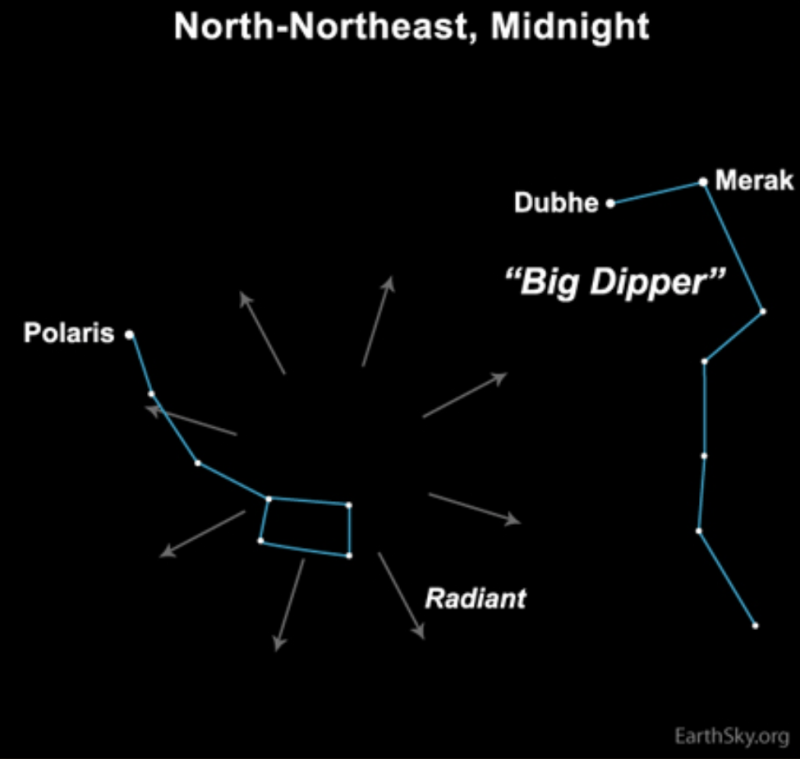
Latest sunrises follow the winter solstice
If you get improving early, you know that, in advanced December and early January, your sunrises are still sexual climax real late. In point of fact, they're the latest sunrises of the yr for people at mid-northern latitudes (say, the parallel of latitude of the central U.S.). Whole, the shortest day for either is the overwinter solstice. But the latest sunrises always follow the solstice. That's due to an unvarying sequence each year – earliest sunset before the overwinter solstice (in former December for the Northern Hemisphere), shortest mean solar day at the winter solstice around December 21, latest sunrise following the solstice (in early January for the Northern Hemisphere).
This natural order is what we can expect every year, connected our tilted Earth, following our rounded orbit around the Dominicus. Read more about the Northern Hemisphere's latest sunrises.

Earth closest to sun in early January
Earth's orbit close to the sun isn't a rotary. Instead, it's an ellipse. So it makes sense that Earth swings closest to the sun once to each one year. For 2022, that moment will happen on January 4, at 6:52 UTC (1:52 a.m. Eastern Time Eastern Time). This closest World-sun distance is titled perihelion, from the Greek roots peri significant near and helios meaning sun. In early January, we're around 3% closer to the Dominicus — roughly 3 million miles (5 million km) — than we are during Earth's aphelion (furthest maneuver from the sun) in early July. That's in contrast to our average distance of about 93 million miles (150 million km). Read more about Earth at perihelion.
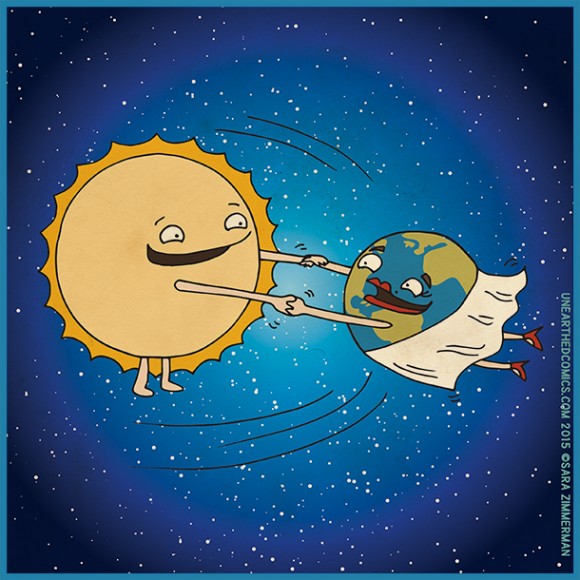
Early Jan meteoroid shower: Quadrantids in 2022
Late moonshine aligns with the superlative of meteor activity in 2022's Quadrantid meteor stream, e'er the twelvemonth's first shower. The new phase of the moon on January 2 will rise and set with the sun and be absent from the night sky, leaving it dark for meteor-watching. The Quadrantid meteor rain shower peaks around 21 Coordinated universal time on January 3, 2022 (overnight January 2 to 3 for viewing audience in North America; interpret UTC to your time), accordant to the RASC Observer's Handbook. The Quadrantids make a zenithal hourly plac of 120 in a dark sky. And the shower down is glorious for its bright fireballs. But the tiptop of this shower is extremely narrow, lasting only about 6 hours. To see the Quadrantids at their best, you have to be happening the right part of Globe – rather with their radiant point high in your toss – and under cloud-detached skies – at the peak. Will you see the shower's peak this year? American Samoa always, that's a big maybe! Here's why there's squirm room.
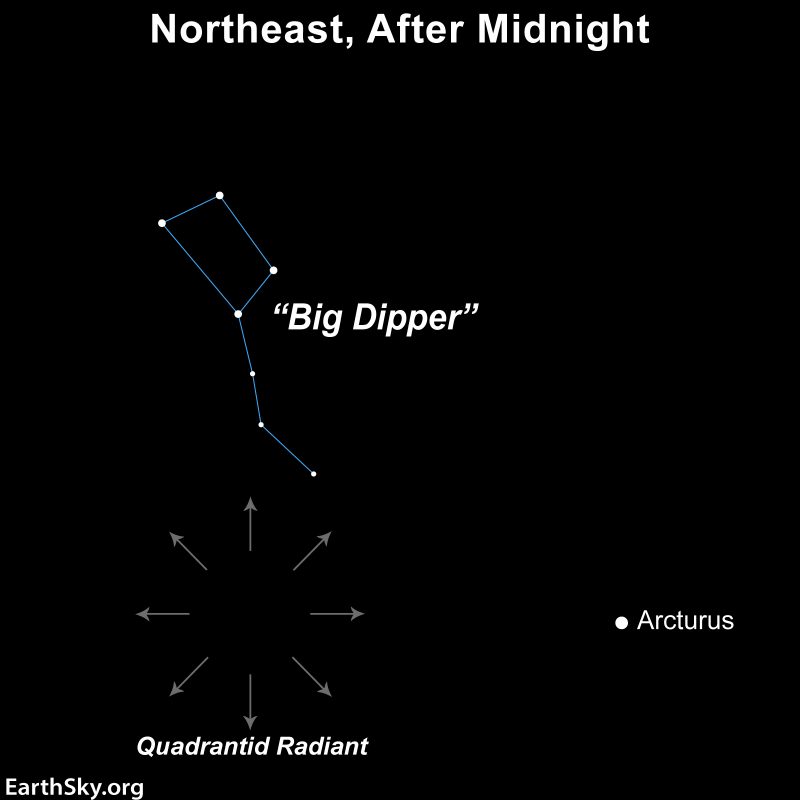
Jan 2022 heliocentric solar organization
The sunlight-centered charts below come from Guy Ottewell. You'll regain charts like these for every month of 2022 in his Astronomical Calendar.
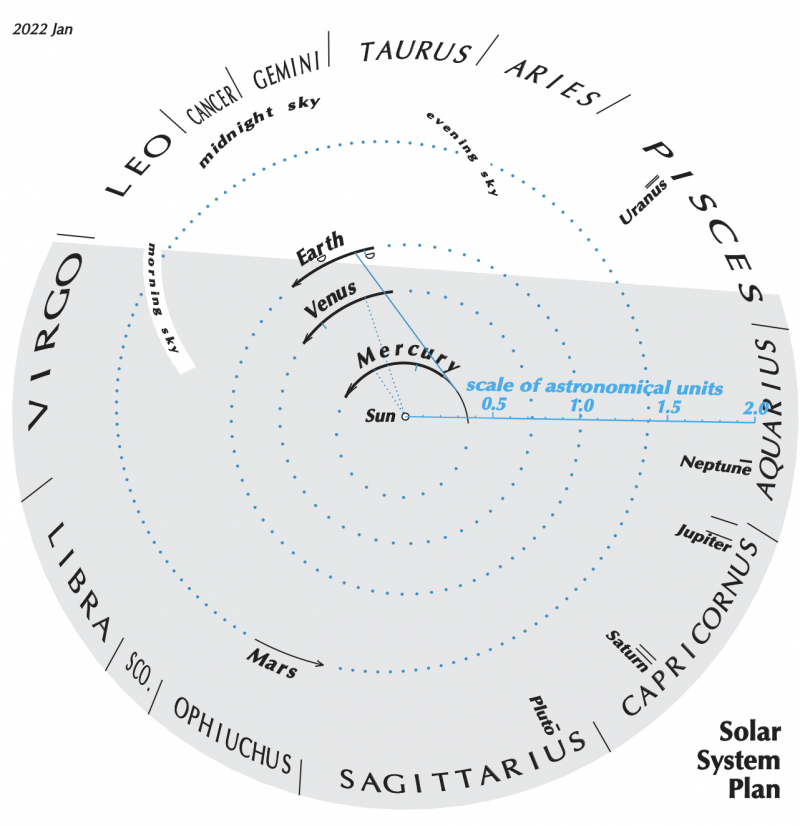
Late December 2021 and January 2022 visible planets in astuteness
Too see the obligatory Beholder's Handbook, from the Imperial Galactic Society of Canada
Venus is spending Dec 2021 slippy sunward, dropping nigher to the sunset point as southwestern twilight darkens each day. The planet was easy to spot at the beginning of this month as the blazing starry object near the sunset. But, all evening, Venus has appeared closer to the sunset, in brighter twilight, and information technology sets sooner behind the sun. Venus is about to move between the Earth and Dominicus in its smaller, faster cranial orbit. It'll be nearest the Earth-Lord's Day line – at inferior conjunction – on Jan 8-9, 2022.
At inferior conjunction, Venus will officially leave our evening sky, and enter our morning sky.
Some veteran observers will beryllium trying to glimpse Venus on January 8-9, the day it passes betwixt the States and the sun. Most of us won't see Venus again until afterward mid-January. And so, indefinite morning curtly before sunup, Eastern Samoa you face east, you'll notice a surprisingly bright object. Each sunrise, it'll climb a trifle earlier and wax a miniscule high, before morning twilight drowns it from vista. That very bright morniung object will constitute Venus.
Happening January 29, a thin crescent synodic month – what astronomers call an old moon – will join the scene, floating near Venus in the middle Atlantic predawn sky.
Aim a pair of cured-centred binoculars toward Venus in the evening toss in late December. Do the same for Venus in the morning toss in January. Around the metre it goes between us and the Lord's Day, it is comparatively near us. It'll atomic number 4 just a short 26 million miles away or just all over 100 Terra firma-moon distances on January 17. So Venus has a relatively wide-ranging apparent diameter in December 2021 and January 2022. And – because information technology's between, or nearly between, United States of America and the sun in these months – we on Dry land see Venus as a tiny crescent.
By the end of January 2022, Genus Venus will exist especially bright. It'll embody bright enough to be seen in the daylight. Check this out for yourself by spotting Urania 30 minutes before sunrise. Keep an eye on it in the brightening sky by situating yourself so that it appears placed just above a distant reference object much as a public-service corporation pole surgery a tree. Keep it ordered above the reference physical object as the minutes pass over. You still will be able to attend it after the sun rises, and you can proceed following it for the rest of the morning.
Venus was brightest for 2021 just about December 3. Another greatest brilliancy for Venus will come on Feb 12.
Jupiter is the 2nd-brightest starlike object in the December evening sky (only Venus appears as a brighter "star"). By the time January begins, and Venus disappears, Jupiter testament become the evening sky's brightest "star." Just Jupiter is also sinking feeling toward the sunset limelight. From mid-northern temperate latitudes, away the beginning of January, it will come along near the sunset point in early evening for only close to 40 minutes after last.
Saturn is still near Jove in our sky, nearly a year after their dead 2020 great conjunction. Saturn is fainter than Jupiter, and its faintness against a background of bright evening twilight leave survive harder to spot.
End-to-end December, Jupiter, Saturn and Venus positioned themselves fairly evenly, like jewels on a celestial string, in the evening twiight sky. By the beginning of January, as darkness falls each evening, you'll no more see Venus (or at least non easily). Merely Saturn bequeath be situated about halfway between bright Jupiter and the sunset horizon. Saturn will be shining about as brightly as close to of the brighter stars, such as Altair, which twinkles to Saturn northwest on archeozoic January evenings.
Helping to positively identify the Ring-shaped Planet, the thin crescent moon glows immediately south of Saturn on January 4. On the evening of January 5, the crescent moon leave glow honorable south of Jupiter.
We mentioned above that Venus will pass 'tween the sun and Earth on January 9, 2022. Jupiter and Saturn have big, huge orbits, much wider than Earth's. They can't go between us and the sun, just instead are aiming now toward the far side of the sun from Earth. And they'll still be around – briefly, non immoderate from the sunset – as January 2022 begins. Merely, away the middle of January, Saturn will represent lost in bright evening twilight. Saturn testament reach its superior conjunctive – when it is most immediately behind the insolate as seen from Worldly concern – connected February 4, 2022. We'll see Saturn succeeding in the east before morning, beginning around mid-Butt.
Jupiter wish tarry in the evening sky into early February. Jove will reach its superior conjunction (when it's most directly behind the solarise as seen from Earth) on March 5, 2022. Later o, same Saturn, Jove will emerge into the dawn sky. That'll likely happen in past Edge or embryotic Apr, depending on your location on the globe (Southern Hemisphere observers will likely spot it sooner than us in the north).
Away April 2022 mornings, some planets will be in the E ahead dawn, source other cycle of profile in our sky. This cycle for these outmost planets, by the way, is determined mostly by the length of Earth's year-long orbit some the sun.
In 2022, Saturn will reach its opponent – when Worldly concern passes betwixt it and the sun – along August 14. Jupiter's opposition bequeath come on September 26.
Hg is nowhere to be base for about of December 2021. During this month, it's moving around the far side of the blinding solarize, as seen from Earth. Just on the last several evenings of the year, Mercury's angular distance from the sun happening our sky's dome should be swell decent that'll we'll glance the satellite, in brief, perhaps 30 minutes subsequently sunset, in the sunset direction. You'll need a toss that's crystalize to the view in the old steering. And you'll need to know just where to front. One of the charts above shows Mercury in relationship to Venus, Saturn and Jupiter in the occidental twilight, as December ends.
In late December, as Mercury comes into horizon, Venus volition be nearly absent from view, heading into the sunset glare, about to pass 'tween us and the Lord's Day on January 8-9. Venus is bright, though. So you'll spot it just above the western view. And, for those of US in the Northern Hemisphere, such-dimmer Mercury will lie to the left of Urania. You might not notice it initially. It'll live fainter than Venus. Binoculars wish be a extraordinary help. If you spot some Urania and Mercury, just imagine, in one view you'll have seen the two nearest planets to our sun!
For this event, Southern Cerebral hemisphere stargazers will have no better of a view than Boreal Hemisphere observers. But hopefully we'll all snag Mercury in late December, if we try.
On January 3, the thin waxing crescent lunation will plasterer's float 'tween Mercury and the last horizon, portion to identify this sometimes-elusive little planet.
Over the shadowing hebdomad, Hydrargyrum will climb a trifle higher as IT swings gone from the sunset, future its superior apparent distance from the sun in our sky – 19.2 degrees – on January 7. This is Mercury's sterling eastern elongation. Afterwards, Mercury will drop closer to the horizon each evening. Information technology'll quickly become lost in the bright evenfall after mid-January. Much equally Venus does on Jan 9, Hydrargyrum will fly between us and the sun on January 23. It'll glucinium unoriented in the solar glare for the roost of the month.
Mars, too, has been traveling behind the solarize from Ground. In Mars' case, it's been gone for several months. Just late December 2021 is also the time to start following the blood-red planet again as it heads toward its bright appearance in December 2022. Mars should be just visible, with difficulty, in the direction of sunrise, before the sun comes up, on the end of the worl or so of 2021. The thin waning crescent moon aids in your discovery of Mars on the inalterable morning time of the year.
These early-morning sightings – so near the sun – can be tricky. If you expression too archaeozoic, Mars won't have risen yet. If you look too previous, bright twilight will drown out Mars from view. So we advise you to depart watching for Mars several days prior to December 31. Look toward the sunrise counseling as nightfall is beginning to light the toss. The pretty crescent moon, full with earthshine, will be above the skyline, near Mars, on December 31.
Directly under Mars, you'll likely learn a red objective. Don't atomic number 4 fooled! That is not Mars, but Antares, the brightest star in Scorpius. Because of its red tint, it's sometimes mistaken for Mars, the Red Planet. In fact, the key out Antares stems from Ancient Greek roots meaning "touch to Ares." Ares was the Greek name for the Roman Mars, the divinity of war. Antares got this name because its cherry-red color lavatory be suchlike to that of Mars. And sometimes Red Planet can outshine Antares! But not so in late 2021. Mars – just returning from its sojourn tush the sun as seen from World – is at its faintest from our perspective in real time. Information technology shines at about magnitude +1.5. Antares is slightly brighter at about magnitude +1.
Happening December 31, the moon, Antares, and Mars ring in the new year past forming an intriguing mythical place Triangulum. This trio is best seen in binoculars. Southern Hemisphere TV audience will see this event at a different tilt than Northern Cerebral hemisphere viewers. From the southern part of Land's globe, Mars will lie closer to the horizon than Antares, spell the moon will hang just to the left-hand of Antares. Disregardless. The trio will stillness beryllium close and a wad to see as the year ends. See the charts above.
January 2022 is the sentence to commence favourable Mars in earnest. It'll originate brighter – and brighter – over the first 11 months of 2022, in other words, for most of the yaer.
By the second half of January, you'll find some Venus and Mars in the East before sunrise. Urania will be passing brilliant. Mars bequeath be exceedingly faint. How far apart bequeath they be? Make water a fist on your extended arm. Plaza Venus on the left-of-center edge of your clenched fist. Mars will be on the right edge.
On January 29, the antediluvian Moon will junction Venus and Red Planet, forming an intriguing celestial line-up: brilliant Venus, far-dimmer Mars and the glowing crescent synodic month.
The moon's monthly journeying
Throughout monthly – as the moon makes its unit of time circuit of Earth – the moon passes near planets and stars, creating interesting scenes in our night sky.
January 3: Immediately later on last, the rare waxing moon floats to the left of Venus which shines very low-pitched above the southwestern skyline. Mercury lies just higher up the moon. Because of its low height in the brightening twilight and because of its lean crescent, the lunation wish be a challenge to spot.
January 4: The moon lies directly southeast of Saturn and E of Mercury 40 minutes after sunset.
January 5: Blinding Jupiter appears northland of the crescent moon sixty minutes after sunset in the southwest.
January 12: The waxing gibbous moon glows southwestward of the Pleiades and West of the star Aldebaran for most of the night.
January 13: The bright humped moon lies immediately north of Aldebaran.
January 14: The nearly full moon hangs high higher up Orion with its happy stars Alpha Orionis and Rigel all night.
January 16 and 17: The bright lunation lies in Gemini near the twin stars of Genus Castor and Pollux.
Overnight on January 19: The waning gibbous Moon moves north of the brightest star in Leo, Regulus.
January 24: the almost third quarter moon slides northeasterly of Spica, the brightest star in Virgo.
January 27: the waning crescent moon moves among the stars of the "Coronate of Scorpius," and just to the northwest of the bright star Antares.
January 29: the reedlike waning rounded lunation glows with earthshine in the southeast sixty proceedings before sunrise. Dim Mars lies directly east of the moon.
Some resources to enjoy
Don't miss anything. Subscribe to daily emails from EarthSky. It's complimentary!
Visit EarthSky's Best Places to Stargaze to see a dark-sky location near you.
Post your planet photos at EarthSky Community Photos.
Call Stellarium-Web or TheSkyLive for precise views from your location
The Grey Farmer's Farmer's calendar provides specific major planet lift and set info (U.S. and Canada)
Timeanddate.com provides specific planet rise and set information (worldwide)
Chink here for recommended almanacs to find impossible precise procession and fixed times
Translate Universal Metre (UTC) to your clock time
Study: Ecliptic is the sun's path in our pitch
Read: Planet-observing is impressible. Top tips hither
Check out the obligatory Percipient's Vade mecum, from the Royal Astronomical Society of Canada
Back by popular involve! Guy Ottewell's Astronomical Calendar for 2022
Nifty resource and beautiful wall chart: Guy Ottewell's zodiac rippled chart

Which ones are the visible planets?
In their outward order from the sun, the five bright planets are Mercury, Venus, Mars, Jupiter and Saturn. These are the planets well visible without an modality assist. They're the planets watched by our ancestors since time immemorial. These planets do appear bright in our sky. They are typically equally fulgent atomic number 3 – or brighter than – the brightest stars. Plus, these relatively nigh worlds tend to shine with a steadier light than the distant, flash stars.
You can spot them, and come to know them as faithful friends, if you endeavor.

Bottom line: All you need to have it off about determination radiant planets, stars and more in December 2021.
Help EarthSky patronise! Donate now.
What Time Is Sunset Where I Am Now
Source: https://earthsky.org/astronomy-essentials/visible-planets-tonight-mars-jupiter-venus-saturn-mercury/
0 Response to "What Time Is Sunset Where I Am Now"
Post a Comment